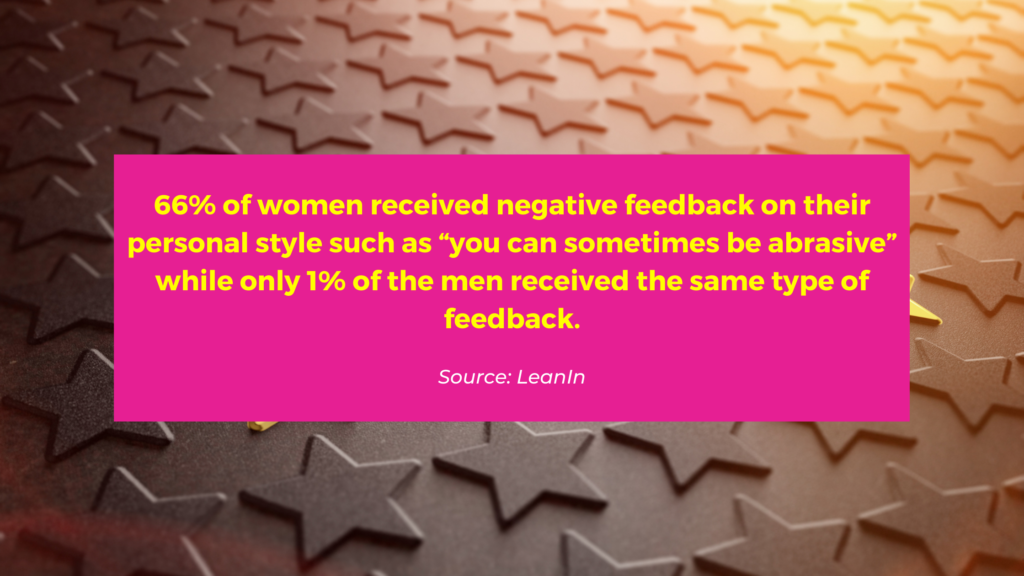Being interrupted in meetings.
Or, being labelled as incompetent and aggressive.
Being told to be grateful for at least having a job when we call out bias.
Being passed over for assignments without reason.
Today, gender bias occurs in more subtle forms. And thus, it’s even more important to call it out, loudly and regularly.
Although unconscious at times, gender bias, especially in the workplace, continues to be a problematic hindrance in a woman’s career trajectory. Today, we’re decoding gender bias in performance reviews as these make or break an individual’s career, especially in a corporate setting. Well-conducted reviews help both employees and companies accomplish their individual and collective goals. However, when reviews are attacked and taken over by unconscious (or conscious) gender bias, women end up taking a bigger hit.
LeanIn conducted a study of performance reviews and here’s what they found out.

While researching further, it became clearer that we women are stuck in a rut without an exit. Assertive women are seen as aggressive. But, soft-spoken women are seen as under-confident, and thus as people that cannot be trusted.
One of the most detailed examples of this has been illustrated in The Power of Talk, a piece by Deborah Tannen. She begins by sharing the following incident.
“The head of a large division of a multinational corporation was running a meeting devoted to performance assessment. Each senior manager stood up, reviewed the individuals in his group, and evaluated them for promotion. Although there were women in every group, not one of them made the cut. One after another, each manager declared, in effect, that every woman in his group didn’t have the self-confidence needed to be promoted. The division head began to doubt his ears. How could it be that all the talented women in the division suffered from a lack of self-confidence?”
As Deborah decoded this further, one important thing became clearer. It is the fact that we grow up in different cultures and surroundings, and around different people and values. And, that’s what the senior manager missed. The women didn’t suffer from a lack of confidence, they just didn’t fit his definition of confidence. And thus, they seemed to be incompetent, leaving him unsure. The reason I’m plugging this example here to highlight the fact that there are a lot of variables to this gender bias. And, as we try to eradicate it, it’s imperative we give attention to all of them. In this case, it was linguistics and communication.
Back to performance reviews. They have been studied deeply to spot gender bias. So, fortunately, or unfortunately, we can all agree that it exists. There’s no doubt about that. And, this acceptance and awareness is also the first step to any kind of course correction. Before we do that, it’s also important to understand the forms of this bias.
A study by Stanford University had shown the following:
When women are evaluated, their reviews contain nearly twice as much talk about their communal or nurturing style, as compared to men. For example, the use of words like helpful or dedicated.
Men are more than three times likely to hear feedback related to a general business outcome. This also means that their reviews focus on technical expertise and vision more than their style of communication.
Women’s performance reviews also contain over two times more talk about team wins as compared to individual ones.
I spotted a pattern here. We’ve moved away from the time when women were simply and directly told that they cannot work, that they do not belong there. Now, we’re in an era where they’re taking space. Where they’re in leadership positions. In fact, according to the Gender Gap Report by World Economic Forum, women’s share of senior and leadership roles has seen a steady global increase over the past five years (2017-2022).
And thus, this deep-rooted bias now shows up in the way we talk, peeps out of “innocent” statements said at work, and out of sheer ignorance.
So, what happens after we see, get furious, and feel this raging urge to drive change?
Well, we change. Like I mentioned earlier, gender bias in performance reviews has been studied extensively. There’s clarity. There’s awareness (not enough, but we’re making progress). And thus, room for improvement.
Here are a few things we can do to rid performance reviews of gender bias.
A. Joint performance reviews
When we think of performance reviews, we imagine a private conversation between two individuals. But, a study by Havard brought in a new perspective. A new way to hold these performance reviews, unaffected by gender bias. And, this way was joint evaluation. They found that when organisations held a joint review, the focus shifted from individuals to what was better for the organisation. And thus, the risk of gender bias seeping in was minimised.
However, I’m aware this one’s tough to implement. And may not work for certain set-ups. So, read ahead.
B. A performance review roundtable
This tip involves individuals who hold these reviews to sit down and review each other’s style of evaluation. Again, gender bias is not always conscious. And thus, when pointed out, can be eradicated. This exercise helps the employees grow as individuals and as an organisation.
C. Stick to structure – a rigid, but important approach
The idea of having open, free-flowing conversations during a review is great, but it’s also what allows room for gender bias. For each thing, we pointed out above. And thus, performance reviews must follow a rigid structure. If women are being questioned about their communication skills, men must be as well. If the focus, for a certain gender, is more on technical skills, it should be that way for everyone, Regardless of gender.
Further, when this structure is being set, it should be evaluated through this lens. Ask questions like, “does this part of the evaluation affect women negatively, as compared to men?” For instance, open-ended questions may seem to affect women more than men. It is because of the internal biases we hold. Thus, it’s imperative to evaluate the evaluation structure before a review is held.
D. Internal awareness sessions
One of the most important things for us to remember, as we hop on this bandwagon to drive change, is that such bias is often unconscious. For instance, it’s not just observed in men in power, but also women in certain positions showcase gender bias. It’s conditioning. And, it’s deep-rooted. Thus, it’s imperative for an organisation to seriously and regularly engage in activities that make them more aware. One of our go-to resources is the 50 Ways to Fight Bias digital program by LeanIn.
That was my bit on gender bias and performance reviews. As I continue to make myself more aware, I will document these examples and learnings. As for the contribution bit, if you’re an organisation or an individual who has been at the centre of things, share your thoughts and experiences with us. Regular dialogue is key here.

